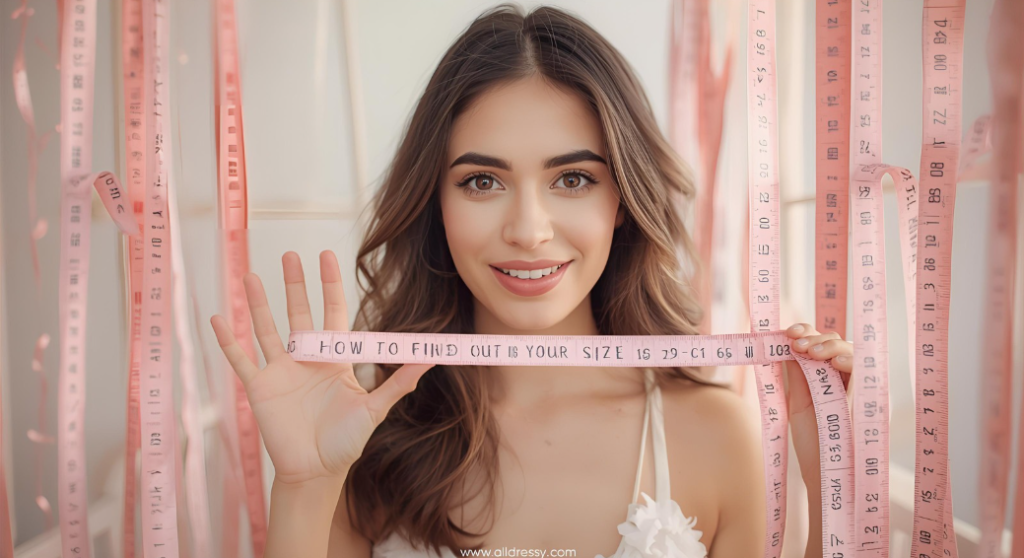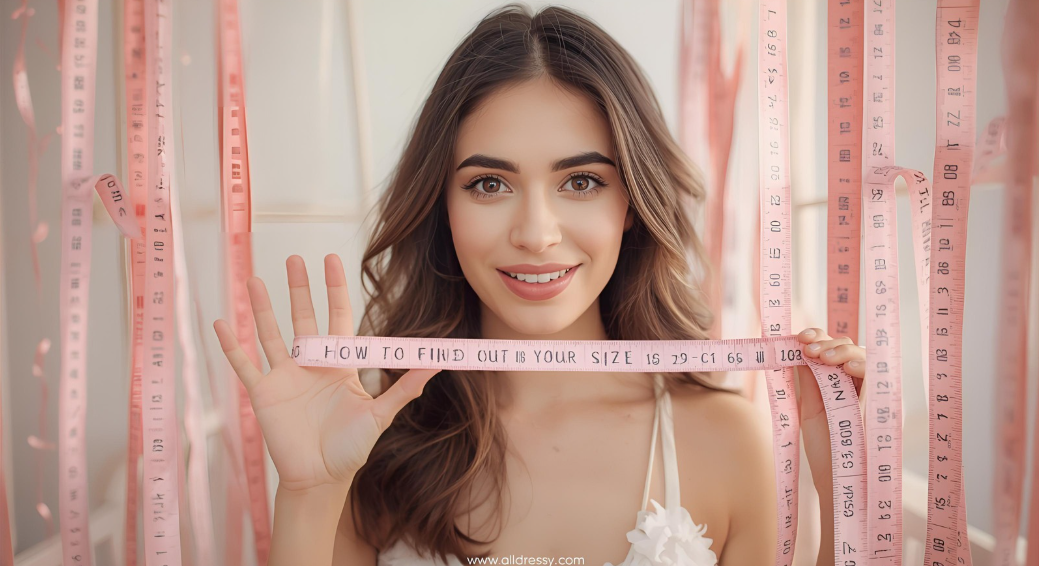Finding the perfect dress can be a challenge, especially when sizes vary between brands and styles. Learning how to find out your dress size is essential for every shopper who wants comfort, confidence, and a flattering fit. This guide provides a comprehensive approach to measuring your body accurately, understanding sizing charts, and navigating differences in fabrics and styles to ensure that every dress you choose fits perfectly.
Why Knowing Your Dress Size Matters

Understanding how to find out your dress size is about more than numbers—it impacts comfort, appearance, and confidence. Properly sized dresses:
- Enhance Comfort: A dress that fits well allows freedom of movement and prevents pinching or tightness.
- Flatter Your Body: Wearing the right size accentuates your curves and creates a polished appearance.
- Save Time and Money: Accurate sizing reduces returns, exchanges, and failed online purchases.
- Boost Confidence: Wearing a well-fitted dress increases self-esteem and helps you feel poised in any setting.
Accurate sizing is essential whether shopping for casual, work, evening, or formal dresses.
Understanding Dress Sizes
Dress sizing varies internationally and between brands, making it important to know your numbers. Common systems include:
- US Sizes: Ranging from 0 to 24, often with petite and tall options.
- UK Sizes: Typically two numbers smaller than US sizes for the same measurements.
- European Sizes: Usually even numbers from 32 to 54.
- Plus Sizes: Specialized sizing for curvier body types, labeled as 1X, 2X, 3X, etc.
- Petite and Tall: Adjusted for shorter or taller frames without changing numerical size.
Understanding these sizing systems allows you to shop internationally and select the best fit for your body.
Key Measurements for Determining Dress Size
Accurate measurements are essential when learning how to find out your dress size. These include:
1. Bust
- Wrap a soft measuring tape around the fullest part of your chest.
- Keep the tape level across your back and snug but not tight.
2. Waist
- Measure at the narrowest part of your waist, typically above the belly button.
- Do not hold your breath or suck in your stomach; measure naturally.
3. Hips
- Measure around the widest part of your hips and buttocks.
- Stand with feet together for consistency.
4. Shoulder Width
- Measure from one shoulder’s edge to the other.
- This helps determine how the dress fits across the upper body.
5. Dress Length
- Measure from the top of your shoulder near the base of the neck down to where you want the hem to fall.
- Important for maxi dresses, formal gowns, and petite or tall adjustments.
Recording these measurements accurately is key to finding the correct dress size.
How to Take Accurate Measurements
Precision is critical when learning how to find out your dress size:
- Use a Soft Measuring Tape: Rigid rulers don’t conform to curves.
- Wear Minimal Clothing: Light clothing prevents added bulk in measurements.
- Measure Twice: Take each measurement at least twice to ensure accuracy.
- Use a Mirror: Helps keep the tape straight and level.
- Get Assistance: A friend can help with hard-to-reach areas like the back.
Proper measurement technique ensures that you select the correct size every time.
Using Size Charts
Once you have your measurements, compare them to size charts:
- Brand-Specific Charts: Sizes can vary between brands; always check the chart of the brand you plan to buy.
- International Conversion: Use conversion charts if shopping internationally.
- Style Differences: A fitted sheath dress requires precise measurements, while an A-line dress is more forgiving.
Understanding size charts is crucial for accurate online or in-store shopping.
Understanding Fit Types
Dresses come in different fits, influencing how your measurements translate to size:
- Bodycon: Form-fitting; requires precise sizing.
- A-Line: Flared at the waist; forgiving around hips and thighs.
- Shift: Loose fit; less dependent on waist measurements.
- Wrap: Adjustable fit; can accommodate multiple sizes.
- Empire Waist: Flare begins just below the bust; forgiving in waist and hip area.
Choosing the right style for your body shape ensures comfort and a flattering appearance.
Tips for Online Shopping
Shopping online requires extra care:
- Check Size Charts: Compare your measurements to the brand’s chart.
- Read Reviews: Look for comments about sizing accuracy and fit.
- Look at Model Info: Many brands include model height and size for reference.
- Consider Fabric: Stretchy fabrics allow more flexibility, structured fabrics need precision.
- Check Return Policies: Ensure you can exchange if the size is incorrect.
Proper preparation allows for confident and successful online shopping.
Accounting for Body Shape
Your body shape influences how a dress fits:
- Hourglass: Balanced bust and hips with a defined waist; fitted or wrap styles are flattering.
- Pear-Shaped: Hips wider than bust; A-line or empire waist dresses work well.
- Apple-Shaped: Wider midsection; empire waist or shift dresses create balance.
- Rectangle: Minimal waist definition; dresses with belts or gathers add curves.
- Inverted Triangle: Broader shoulders than hips; A-line or flared skirts balance proportions.
Selecting styles based on body shape helps ensure the dress fits well and looks flattering.
Adjusting for Fabric and Style
Fabric and design affect how the dress fits your measurements:
- Stretch Fabrics: Allow flexibility; slight measurement differences are tolerable.
- Structured Fabrics: Require exact sizing for proper fit.
- Layered or Lined Dresses: May fit tighter; consider an extra size if between sizes.
- Buttoned or Zippered Dresses: Restrictive fabrics may require precise bust and waist measurements.
Factoring in fabric and style prevents discomfort and ensures a flattering appearance.
Using Tools to Determine Dress Size
Several tools can help when learning how to find out your dress size:
- Measurement Apps: Enter measurements for size recommendations across brands.
- Virtual Fitting Guides: 3D body scanning provides precise sizing suggestions.
- Printable Measurement Guides: Step-by-step instructions for home measurement.
- Size Calculators: Convert US, UK, EU, and plus sizes.
These tools improve accuracy and confidence when shopping.
Alterations and Tailoring
Even with accurate measurements, alterations may be needed:
- Hem Adjustments: Shorten or lengthen dresses for proper fit.
- Seam Adjustments: Take in or let out bust, waist, or hips.
- Sleeve Adjustments: Modify length or width for comfort.
Tailoring ensures that even slightly off-size dresses can be customized to fit perfectly.
Common Mistakes to Avoid
- Assuming Standard Sizes Fit All: Size numbers vary widely between brands.
- Ignoring Body Shape: Bust measurement alone may not determine the correct size.
- Poor Measurement Technique: Inaccurate measurements lead to improper fit.
- Neglecting Fabric Differences: Stretch and structured fabrics behave differently.
- Not Using Size Charts: Always compare measurements to brand-specific charts.
Avoiding these mistakes ensures a better shopping experience and well-fitting dresses.
Special Considerations
- Pregnancy or Postpartum: Look for adjustable or stretchy dresses.
- Plus Sizes: Brands may use different sizing standards; always check measurements.
- Petite or Tall Sizes: Adjusted for proportions; size number alone may not fit.
- Seasonal Dresses: Layered winter dresses may require slightly larger sizing.
Consider these factors to ensure accurate sizing for every occasion.
Maintaining Accurate Measurements
Your body changes over time, so it’s essential to update measurements regularly:
- Measure Every Six Months: Ensure sizing remains accurate.
- Record Measurements and Brand Sizes: Keep a reference for future shopping.
- Recheck Before Online Orders or Events: Confirm measurements for critical purchases.
Maintaining updated measurements ensures consistency and comfort across your wardrobe.
Shopping In-Store vs Online
In-Store Shopping:
- Allows for trying on multiple sizes and styles.
- Immediate feedback on fit and comfort.
- Opportunity to see how the dress looks with accessories and shoes.
Online Shopping:
- Offers wider selection and international brands.
- Requires reliance on accurate measurements and size charts.
- Reading reviews and using virtual fitting tools improves confidence.
Understanding the advantages of each shopping method helps make the process smoother and more successful.
Handling Fit Between Sizes
- When Between Sizes: Consider the dress style, fabric, and intended fit.
- Stretch or Loose Styles: Smaller sizes may work comfortably.
- Structured or Fitted Styles: Larger size may be necessary for comfort.
- Alterations: Minor adjustments can bridge gaps between sizes.
Being mindful of these options ensures a flattering and comfortable fit.
Frequently Asked Questions (FAQs)
1. How do I find out my dress size at home?
Use a soft measuring tape to measure your bust, waist, hips, and shoulder width. Compare these measurements with the specific brand’s size chart to determine your correct size.
2. Why do dress sizes vary between brands?
Sizes differ due to variations in brand sizing standards, fabric types, and style designs. Always check the brand-specific size chart instead of relying solely on a general size number.
3. Should I consider my body shape when choosing a dress?
Yes. Body shapes like hourglass, pear, apple, rectangle, and inverted triangle affect how a dress fits. Select styles that flatter your proportions for the best look and comfort.
4. How do fabrics affect sizing?
Stretchy fabrics allow for some flexibility, while structured or lined fabrics require precise measurements. Consider fabric composition when selecting a size.
5. Can I rely solely on dress size numbers when shopping online?
No. Size numbers vary across brands and countries. Always compare your measurements to the brand’s size chart and read reviews for fit guidance.
6. How often should I re-measure myself?
Measure every six months or after any significant weight changes to ensure your dress size remains accurate.
7. What if a dress doesn’t fit perfectly?
Tailoring can adjust hems, seams, or sleeves for a better fit. Even slightly off-size dresses can be customized to suit your body.
8. What should I do if I’m between sizes?
Consider the style and fabric of the dress. Stretchy or loose-fitting dresses may work with a smaller size, while fitted styles may require sizing up.
9. Are petite and tall sizes the same as regular sizes?
No. Petite and tall sizes adjust the dress’s proportions, not just the numeric size. Always use measurements rather than relying on size alone.
Conclusion
Learning how to find out your dress size is essential for comfort, confidence, and style. By taking accurate measurements, understanding body shape, considering fabric and style, and consulting brand-specific size charts, you can shop with confidence and reduce the frustration of returns or ill-fitting dresses.
Maintaining updated measurements and knowing tailoring options ensures that every dress fits perfectly, whether purchased online or in-store. Accurate sizing not only saves time and money but also enhances your personal style, helping you select outfits that complement your body and make you look and feel your best.

